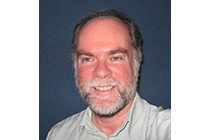Profile
I specialise in the study living and fossil ostracod crustaceans, both marine and freshwater, and their applications in palaeoclimatology, palaeoceanography, biogeography, crustacean phylogeny and the evolution of sex and parthenogenesis. I also work on Mesozoic and Palaeozoic ostracods and their applications. Current efforts are focused on further development of my Mutual Ostracod Temperature Range method for Quaternary palaeoclimate reconstruction, in parallel with the application of a Multi-Proxy Consensus approach to the testing and refinement of the results of such methods. I also work on Mesozoic and Palaeozoic ostracods and their applications. I collaborate in multidisciplinary research with scientists in the UK as well as mainland Europe, Japan, Canada and North America. I explore Mars in my spare time.
Key publications
-
Wang, H., Matzke-Karasz, R., Horne, D.J., Zhao, X., Cao, M., Zhang, H. & Wang, B. 2020. Exceptional preservation of reproductive organs and giant sperm in Cretaceous ostracods. Proceedings of the Royal Society, B: Biological Sciences, 287, 20201661.
-
Farjon, A., Horne, D.J., Parfitt, S.A., Buckland, P.I. & Lewis, M.D. 2020. Early Pleistocene conifer macrofossils from Happisburgh, Norfolk, UK, and their environmental implications for early hominin occupation. Quaternary Science Reviews, 232, 106115.
-
Marchegiano, M., Horne, D.J., Gliozzi, E., Francke, Alexander, Wagner, B. & Ariztegui, D. 2020. Rapid Late Pleistocene climate change reconstructed from a lacustrine ostracod record in central Italy (Lake Trasimeno, Umbria). Boreas, 49, 739–750.
- Crasquin, S. & Horne, D.J. 2018. The palaeopsychrosphere in the Devonian. Lethaia, 51, 547-563.
-
Williams, L.R., Hiscott, R.N., Aksu, A.E., Bradley, L.R., Horne, D.J. & Stoica, M. 2018. Holocene paleoecology and paleoceanography of the southwestern Black Sea shelf revealed by ostracod assemblages. Marine Micropaleontology, 142, 48-66.
- Horne, D.J., Curry, B.B. & Mesquita-Joanes, F. 2012. Mutual climatic range methods for Quaternary ostracods. In: Horne, D.J., Holmes, J.A., Rodriguez-Lazaro, J. & Viehberg, F. (eds) Ostracoda as Proxies for Quaternary Climate Change. Developments in Quaternary Science 17, 65-84. Elsevier.
- Horne, D. J. 2007. A Mutual Temperature Range method for Quaternary palaeoclimatic analysis using European nonmarine Ostracoda. Quaternary Science Reviews, 26, 1398-1415.
Teaching
Between joining QMUL in September 2003 and my retirement in September 2020 I taught a wide range of undergraduate topics including environmental hazards, Quaternary palaeoenvironments, and Geographical Information Systems. I liked to integrate lectures with workshops, seminars and practical work in the classroom or laboratory and in the field, and was active in developing and using e-learning resources and a "flipped classroom" approach.
I was Director of Taught Programmes for the School of Geography (2016-2019). I worked with QMUL Thinking Writing staff on several projects including CLEAR (Critical Literature Evaluation & Review), a QMUL team contribution (chaired by Morag Shiach) to the Higher Education Academy’s programme Developing and Embedding Inclusive Policies and Practices, a QMUL Working Group on Developing Students' Writing, and DALiC (Developing Academic Literacy in Context). Writing workshops linked to group-based coursework assignments, jointly run with Thinking Writing staff, were a key feature of my Environmental Hazards module. In 2013 I received the QMUL Students' Union Assessment & Feedback award. I gained a Higher Education Academy Teaching Fellowship in 2016.
When teaching in the field became impossible during the Covid-19 pandemic I began developing and deploying Virtual Field Experience resources, an activity that I have continued, in retirement, in support of QMUL Geography colleagues and as a member of the Virtual Palaeoscience project (https://virtualpalaeoscience.wordpress.com/).
Research
Research Interests:
Quaternary and Recent ostracods and their applications
Ostracods are common microfossils in Quaternary (Pleistocene and Holocene) deposits. Their ecological diversity makes them useful as palaeoenvironmental proxies in oceanic, coastal and continental settings; they are also particularly valuable for reconstructing Quaternary palaeoclimatic conditions and can be helpful for correlating and establishing the relative ages of the deposits in which they are found. My research involves all of these applications, often as a member of a multidisciplinary team, as well as studies of Recent (living) ostracod taxonomy, ecology and distribution which are essential to understand better their significance as fossil proxies.
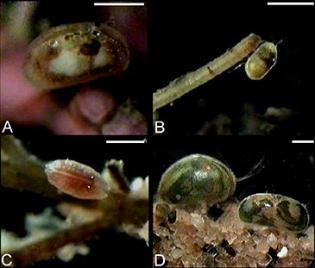
Some living ostracods.
A–C: marine-brackish cytheroidean podocopids; D: freshwater cypridoidean podocopids.
Scale bars approx. 1 mm.
Ostracoda as proxies for Quaternary climate change
The value of ostracods value as Quaternary palaeoclimate proxies, through indicator species, transfer function, mutual climatic range and geochemical approaches, is the focus of a major book project to which 39 international authors contributed, of which I was the lead editor and which was published at the end of 2012.
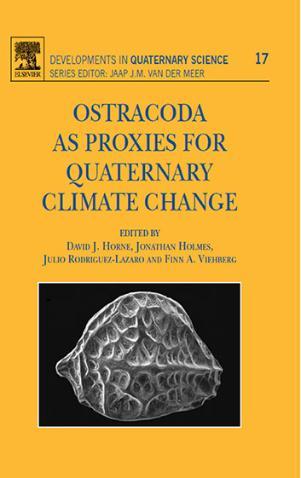
The Mutual Ostracod Temperature Range method
The Mutual Ostracod Temperature Range (MOTR) method combines nonmarine ostracod distributional data (e.g. from the NODE database) with modern climate data to establish species’ mean air temperature ranges (e.g. for January and July); thus calibrated, overlapping ranges of fossil ostracods in Quaternary assemblages are used to determine the mutual temperature range within which they could have co-existed. This has facilitated quantitative palaeoclimate reconstructions for British Pleistocene archaeological sites including Boxgrove and Purfleet, as well as (most recently) a Late Peistocene record from lake Trasimeno in Italy. See, e.g.:
- Marchegiano, M., Horne, D.J., Gliozzi, E., Francke, Alexander, Wagner, B. & Ariztegui, D. 2020. Rapid Late Pleistocene climate change reconstructed from a lacustrine ostracod record in central Italy (Lake Trasimeno, Umbria). Boreas, 49, 739–750.
- Langford, H.E., Boreham, S., Briant, R.M., Coope, G.R., Horne, D.J., Penkman, K.E.H., Schreve, D.C., Whitehouse, N.J. & Whittaker, J.E. 2017. Evidence for the early onset of the Ipswichian thermal optimum: palaeoecology of Last Interglacial deposits at Whittlesey, eastern England. Journal of the Geological Society, 174, 988-1003.
- Bridgland, D., Harding, P., Allen, P., Candy, I., Cherry, C., George, W., Horne, D. J., Keene, D.H., Penkman, K. E. H., Preece, R.C., Rhodes, E., Scaife, R., Schreve, D.C., Schwenninger, J.L., Slipper, I., Ward, G., White, M.J., White, T.S. & Whittaker, J.E. 2013. An enhanced record of MIS 9 environments, geochronology and geoarchaeology: data from construction of the High Speed 1 (London–Channel Tunnel) rail-link and other recent investigations at Purfleet, Essex, UK. Proceedings of the Geologists’ Association, 124, 417-476.
- Horne, D.J., Curry, B.B. & Mesquita-Joanes, F. 2012. Mutual climatic range methods for Quaternary ostracods. In: Horne, D.J., Holmes, J.A., Rodriguez-Lazaro, J. & Viehberg, F. (eds) Ostracoda as Proxies for Quaternary Climate Change. Developments in Quaternary Science 17, 65-84. Elsevier.
- Holmes, J. A., Atkinson, T., Darbyshire, D. P. F., Horne, D. J., Joordens, J., Roberts, M. B., Sinka, K. J. & Whittaker, J. E. 2010. Middle Pleistocene climate and hydrological environment at the Boxgrove hominin site (West Sussex, UK) from ostracod records. Quaternary Science Reviews, 29, 1515-1527.
- Horne, D. J. 2007. A Mutual Temperature Range method for Quaternary palaeoclimatic analysis using European nonmarine Ostracoda. Quaternary Science Reviews, 26, 1398-1415.
The NODE (Nonmarine Ostracod Distribution in Europe) database
The primary "training set" source for the MOTR method is the NODE database, initiated by members of an EU-funded project (Evolutionary Ecology of Reproductive Modes in Non-marine Ostracoda: 1994–1996) and further developed in support of two other EU-funded projects (Fauna Europaea: 2000–2004; From Sex to Asex: a case study on interactions between sexual and asexual reproduction: 2004–2008). It contains approximately 10,000 records of living species and 2,000 fossil (Quaternary) records; current efforts are aimed at (1) checking and validating the coordinates of georeferenced species occurrence records, and (2) taxonomic hamornisation with other major northern hemisphere (Holarctic) ostracod databases, as a precursor to contributing a dataset to the Neotoma Paleoecology Database (https://www.neotomadb.org/).
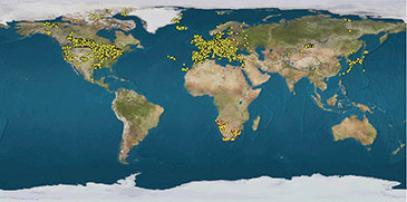
Nonmarine ostracod datasets in North America, Europe, East Asia and southern Africa.
Ostracods as palaeoceanographic proxies
The widely accepted “Platycopid Signal” Hypothesis claims that fossil ostracod assemblages dominated by the Order Platycopida signal dysaerobic conditions on the sea floor, based on the premise that filter-feeding platycopids, able to pass more water over their respiratory surface, were better-equipped than other ostracods to survive in poorly oxygenated waters. I and co-authors have challenged claims of modern biological and ecological support for the Platycopid Signal and have advanced an alternative interpretation, suggesting that platycopid dominance may signify oligotrophy rather than dysaerobia, because living platycopids appear adapted to filter-feed on nano- and picoplankton which are predominant in oligotrophic conditions.
- Horne, D. J., Brandão, S. N. & Slipper, I. J. 2011. The Platycopid Signal deciphered: responses of ostracod taxa to environmental change during the Cenomanian-Turonian Boundary Event (Late Cretaceous) in SE England. Palaeogeography, Palaeoclimatology, Palaeoecology, 308, 304-312

A present-day platycopid ostracod from the coast of Japan.
Purbeck-Wealden ostracods: biostratigraphy and palaeoenvironments
The mid-Mesozoic was a time of explosive global diversification of nonmarine ostracod faunas, establishing lineages that persist to this day. My research on ostracod assemblages of Jurassic–Cretaceous continental deposits (the "Purbeck-Wealden" in Britain) includes revisions of their taxonomy, biostratigraphical zonation schemes and palaeoenvironmental interpretations that have implications for Mesozoic nonmarine basins worldwide. The application of a palaeobiological approach to the interpretation of Purbeck-Wealden ostracod assemblages has been particularly rewarding; for example, a combination of pollen and ostracod fossils provided evidence for temporary freshwater pond conditions associated with a dinosaur skeleton in a Cretaceous Weald Clay pit in Surrey.
- Nye, E., Feist-Burkhardt, S., Horne, D. J., Ross, A. J. & Whittaker, J. E. 2008. The palaeoenvironment associated with a partial Iguanodon skeleton from the Upper Weald Clay (Barremian, Early Cretaceous) at Smokejacks Brickworks (Ockley, Surrey, UK), based on palynomorphs and ostracods. Cretaceous Research, 29, 417-444.
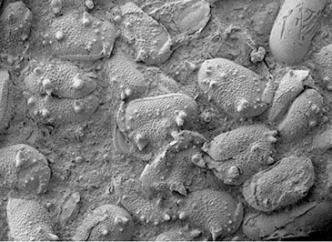
Fossil freshwater ostracod shells on the bed of a Cretaceous lake in southern England.
Ostracod evolution and phylogeny
Ostracod shells provide the best fossil record of any arthropods, extending back 500 million years, but the rarity of preservation of their appendages and other "soft parts" impedes efforts to understand their phylogenetic relationships. Ostracods are well-known for providing examples of geographical parthenogenesis and unusual longevity of asexual reproduction. As a micropalaeontologist I collaborate with zoologists, ecologists and molecular biologists in studying ostracods and crustacean phylogeny as well as the evolutionary ecology of sex and parthenogenesis, e.g. as a participant in the EU-funded project: From Sex to Asex: a case study on interactions between sexual and asexual reproduction (2004–2008). Related research highlights include the first confirmed records of rare living males in the "ancient asexual" darwinulid ostracods, and confirmation of the remarkable antiquity of sexual reproduction involving "giant" sperm in a Cretaceous ostracod preserved in amber. See, e.g.:
- Wang, H., Matzke-Karasz, R., Horne, D.J., Zhao, X., Cao, M., Zhang, H. & Wang, B. 2020. Exceptional preservation of reproductive organs and giant sperm in Cretaceous ostracods. Proceedings of the Royal Society, B: Biological Sciences, 287, 20201661.
- Schmit , O., Bode, S.N.S., Camacho, A., Horne, D.J., Lamatsch, D.K., Martens, K., Martins, M.J.F., Namiotko, T., Rossetti, G., Rueda-Sevilla, J., Schön, I., Vandekerkhove & Mesquita-Joanes, F. 2013. Linking present environment and the segregation of reproductive modes (geographical parthenogenesis) in Eucypris virens (Crustacea: Ostracoda). Journal of Biogeography, 40, 2396-2408.
- Smith, R. J., Kamiya, T. & Horne, D. J. 2006. Living males of the 'ancient asexual' Darwinulidae (Ostracoda: Crustacea). Proceedings of the Royal Society of London, series B (Biological Sciences), 273, 1569-1578.
https://www.discoverwildlife.com/news/100-million-year-old-giant-sperm-is-worlds-oldest/
Publications
I have published more than 160 journal articles, book chapters and edited books since completing my PhD in 1980. Selected publications are listed below according to research topics.
Quaternary–Recent ostracods and their palaeoenvironmental applications
-
Roberts, L.R., Holmes, J.A., Sloane, H.J., Arrowsmith, C., Leng, M.J. & Horne, D.J. 2020. δ18O and δ13C of Cyprideis torosa from coastal lakes: Modern systematics and down-core interpretation. Marine Micropaleontology, 160, 101907.
-
Neretina, A.N., Gololobova, M.A., Neplyukhina, A.A., Zharov, A.A., Rogers, C.D., Horne, D.J., Protopopov, A.V. & Kotov, A. 2020.Crustacean remains from the Yuka mammoth raise questions about non-analog freshwater communities in the Beringian region during the Pleistocene. Scientific Reports, 10 (859), 10 pp.
-
Roberts, L.R., Holmes, J.A. & Horne, D.J. 2020. Tracking the seasonal calcification of Cyprideis torosa (Crustacea, Ostracoda) using Mg/Ca-inferred temperatures, and its implications for palaeotemperature reconstruction. Marine Micropaleontology, 156, 101838.
- Wang, H., Xu, H., Zhang, H., Cao, M. & Horne, D.J. 2019. Possible predation damage and repair in a Quaternary marine ostracod. Lethaia, 53, 310-315.
-
Horne, D.J., Meisch, C. & Martens, K. 2019. Arthropoda: Ostracoda. In: Rogers, D.C. & Thorp, J. (Eds), Thorp and Covich’s Freshwater Invertebrates, Fourth Edition, Volume IV, Keys to Palaearctic Fauna, Ch. 16.3, 725-760. Academic Press.
-
Wang, H., Zhang, H., Cao, M. & Horne, D.J. 2019. Holocene Ostracods from the Hang Hau Formation in Lei Yue Mun, Hong Kong, and their palaeoenvironmental implications. Alcheringa, 43, 320-333.
-
Williams, L.R., Hiscott, R.N., Aksu, A.E., Bradley, L.R., Horne, D.J. & Stoica, M. 2018. Holocene paleoecology and paleoceanography of the southwestern Black Sea shelf revealed by ostracod assemblages. Marine Micropaleontology, 142, 48-66.
-
Roberts, L. R., Holmes, J.A., Leng, M.J., Sloane, H.J. & Horne, D.J. 2018. Effects of cleaning methods upon preservation of stable isotopes and trace elements in shells of Cyprideis torosa (Crustacea, Ostracoda): Implications for palaeoenvironmental reconstruction. Quaternary Science Reviews, 189, 197-209.
-
Pint, A., Schneider, H., Frenzel, P., Horne, D.J., Voigt, M. & Viehberg, F. 2017. Late Quaternary salinity variation in the Lake of Siebleben (Thuringia, Central Germany) – methods of palaeoenvironmental analysis using Ostracoda and pollen. The Holocene, 27, 526-540.
-
Horne, D.J., Benardout, G. & Whittaker, J.E. 2017. Cyprideis torosa (Jones, 1850) in its type area and stratigraphical context: potential for mapping the freshwater/estuarine boundaries of the Thames–Medway river system in the MIS9 and MIS11 interglacials. Journal of Micropalaeontology, 36, 127-13
- Smith, A.J. & Horne, D.J. 2016. Class Ostracoda. In: Thorp, J. & Rogers, D.C. (Eds), Keys to Nearctic Fauna, 477-514. Thorp and Covich’s Freshwater Invertebrates, Fourth Edition, Volume II Academic Press.
- Pint, A., Frenzel, P., Horne, D.J., Franke, J., Daniel, T., Burghardt, A., Funai, B., Lippold, K., Daut, G. & Wennrich, V. 2015. Ostracoda from inland waterbodies with saline influence in Central Germany: Implications for palaeoenvironmental reconstruction. Palaeogeography, Palaeoclimatology, Palaeoecology, 419, 37-46.
- Candy, I. & Horne, D.J. 2014. The Hoxnian interglacial, MIS 11 and the lacustrine sequence at Marks Tey, Essex. In: Bridgland, D.R., Allen, P. & White, T.S. (Eds). The Quaternary of the Lower Thames & eastern Essex: Field Guide, 79-91. The Quaternary Research Association, London.
- Horne, D.J., Bal, D., Benardout, G., Huckstepp, T., Lewis, S.G. & March, A. 2014. Ostracods from Marks Tey: palaeoenvironmental and palaeoclimate implications. In: Bridgland, D.R., Allen, P. & White, T.S. (Eds). The Quaternary of the Lower Thames & eastern Essex: Field Guide, 100-108. The Quaternary Research Association, London.
- Brandão, S.N., Yasuhara, M., Irizuki, T. & Horne, D.J. 2013. The ostracod genus Trachyleberis (Crustacea; Ostracoda) and its type species. Marine Biodiversity, DOI 10.1007/s12526-013-0163-6.
- Peacock, J.D., Horne, D.J. & Whittaker, J.E. 2012. Late Devensian evolution of the marine offshore environment of western Scotland. Proceedings of the Geologists’ Association, 123, 419-437.
- Horne, D. J., Jocque, M., Brendonck, L. & Martens, K. 2011. On Potamocypris compressa (Crustacea, Ostracoda) from temporary rock pools in Utah, USA, with notes on the taxonomic harmonisation of North American and European ostracod faunas. Zootaxa, 2793, 35-46.
- Keatings, K., Holmes, J., Flower, R., Horne, D., Whittaker, J. E. & Abu-Zied, R. H. 2010. Ostracods and the Holocene palaeolimnology of Lake Qarun, with special reference to past human–environment interactions in the Faiyum (Egypt). Hydrobiologia, 654, 155-176.
- Whittaker, J. E. & Horne, D. J. 2009. Pleistocene. In: Whittaker, J. E. & Hart, M. B. (eds), Ostracods in British Stratigraphy. The Micropalaeontological Society, Special Publications, 447–467.
- Martens, K., Schön, I., Meisch, C. & Horne, D. J. 2008. Global diversity of ostracods (Ostracoda, Crustacea) in freshwater. Hydrobiologia, 595, 185-193.
- Horne, D. J., Smith, R. J., Whittaker, J. E. & Murray, J. W. 2004. The first British record and a new species of the superfamily Terrestricytheroidea (Crustacea, Ostracoda): morphology, ontogeny, lifestyle and phylogeny. Zoological Journal of the Linnean Society,142, 253-288.
- Boomer, I., Horne, D. J. & Slipper, I. J. 2003. The use of ostracods in palaeoenvironmental studies, or what can you do with an ostracod shell? In Park, L. E. & Smith, A. J. (eds), Bridging the gap: trends in the ostracode biological and geological sciences. The Paleontological Society Papers, 9, 153-179.
- Horne, D. J., Cohen, A. & Martens, K. 2002. Taxonomy, morphology and biology of Quaternary and living Ostracoda, In Holmes, J. A. & Chivas, A. R. (eds), The Ostracoda: Applications in Quaternary research, AGU Geophysical Monograph Series, Vol. 131, 5-36.
- Smith, A. J. & Horne, D. J. 2002. Ecology of marine, marginal marine and nonmarine ostracodes. In Holmes, J. A. & Chivas, A. R. (eds), The Ostracoda: Applications in Quaternary research, AGU Geophysical Monograph Series, Vol. 131, 37-64.
Quaternary palaeoclimate reconstruction
-
Marchegiano, M., Horne, D.J., Gliozzi, E., Francke, Alexander, Wagner, B. & Ariztegui, D. 2020. Rapid Late Pleistocene climate change reconstructed from a lacustrine ostracod record in central Italy (Lake Trasimeno, Umbria). Boreas, 49, 739–750.
-
Farjon, A., Horne, D.J., Parfitt, S.A., Buckland, P.I. & Lewis, M.D. 2020. Early Pleistocene conifer macrofossils from Happisburgh, Norfolk, UK, and their environmental implications for early hominin occupation. Quaternary Science Reviews, 232, 106115.
- Langford, H.E., Boreham, S., Briant, R.M., Coope, G.R., Horne, D.J., Penkman, K.E.H., Schreve, D.C., Whitehouse, N.J. & Whittaker, J.E. 2017. Evidence for the early onset of the Ipswichian thermal optimum: palaeoecology of Last Interglacial deposits at Whittlesey, eastern England. Journal of the Geological Society, 174, 988-1003.
- Horne, D. J. 2014. Interglacial palaeotemperature reconstructions for MIS11 and MIS9 in SE England. In: Bridgland, D.R., Allen, P. & White, T.S. (Eds). The Quaternary of the Lower Thames & eastern Essex: Field Guide, 23-27. The Quaternary Research Association, London.
- Langford, H.E., Boreham, S., Briant, R.M., Coope, G.R., Horne, D.J., Schreve, D.C., Whittaker, J.E. & Whitehouse, N.J. 2014. Middle to Late Pleistocene palaeoecological reconstructions and palaeotemperature estimates for cold/cool stage deposits at Whittlesey, eastern England, Quaternary International, 341, 6-26.
- Langford, H.E., Boreham, S., Coope, G.R., Fletcher,W., Horne, D.J., Keen, D.H., Mighall T., Penkman, K.E.H., Schreve, D.C. & Whittaker, J.E. 2014. Palaeoecology of a late MIS 7 interglacial deposit from eastern England. Quaternary International, 341, 27-45.
- Whittaker, J.E., Horne, D.J. & Wenban-Smith, F. 2013. Chapter 11. Ostracods and other microfossils. In: Wenban-Smith, F. (Ed.). The Ebbsfleet Elephant. Excavations at Southfleet Road, Swanscombe in advance of High Speed 1, 2003-4. Oxford Archaeology Monograph No 20, 275-289.
- Bridgland, D., Harding, P., Allen, P., Candy, I., Cherry, C., George, W., Horne, D. J., Keene, D.H., Penkman, K. E. H., Preece, R.C., Rhodes, E., Scaife, R., Schreve, D.C., Schwenninger, J.L., Slipper, I., Ward, G., White, M.J., White, T.S. & Whittaker, J.E. 2013. An enhanced record of MIS 9 environments, geochronology and geoarchaeology: data from construction of the High Speed 1 (London–Channel Tunnel) rail-link and other recent investigations at Purfleet, Essex, UK. Proceedings of the Geologists’ Association, 124, 417-476.
- Horne, D.J., Curry, B.B. & Mesquita-Joanes, F. 2012b. Mutual climatic range methods for Quaternary ostracods. In: Horne, D.J., Holmes, J.A., Rodriguez-Lazaro, J. & Viehberg , F. (eds) Ostracoda as Proxies for Quaternary Climate Change. Developments in Quaternary Science 17, 65-84. Elsevier.
- Horne, D.J., Holmes, J.A., Rodriguez-Lazaro, J. & Viehberg , F. (eds) 2012a. Ostracoda as Proxies for Quaternary Climate Change. Developments in Quaternary Sciences 17, 373 pp. Elsevier.
- Holmes, J. A., Atkinson, T., Darbyshire, D. P. F., Horne, D. J., Joordens, J., Roberts, M. B., Sinka, K. J. & Whittaker, J. E. 2010. Middle Pleistocene climate and hydrological environment at the Boxgrove hominin site (West Sussex, UK) from ostracod records. Quaternary Science Reviews, 29, 1515-1527.
- Horne, D. J. & Mezquita, F. 2008. Palaeoclimatic applications of large databases: developing and testing methods of palaeotemperature reconstruction using nonmarine ostracods. Senckenbergiana lethaea, 88, 93-112.
- Horne, D. J. 2007. A Mutual Temperature Range method for Quaternary palaeoclimatic analysis using European nonmarine Ostracoda. Quaternary Science Reviews, 26, 1398-1415.
- Brouwers, E. M., Cronin, T. M., Horne, D. J. & Lord, A. R. 2000. Recent shallow marine ostracods from high latitudes: implications for late Pliocene and Quaternary palaeoclimatology. Boreas, 29, 127-143.
Ostracods and pre-Quaternary palaeoenvironments and palaeoceanography
-
Crasquin, S. & Horne, D.J. 2018. The palaeopsychrosphere in the Devonian. Lethaia, 51, 547-563.
- Horne, D. J., Brandão, S. N. & Slipper, I. J. 2011. The Platycopid Signal deciphered: responses of ostracod taxa to environmental change during the Cenomanian-Turonian Boundary Event (Late Cretaceous) in SE England. Palaeogeography, Palaeoclimatology, Palaeoecology, 308, 304-312.
- Brandão, S. N. & Horne, D. J. 2009. The Platycopid Signal of oxygen depletion in the ocean: a critical evaluation of the evidence from modern ostracod biology, ecology and depth distribution. Palaeogeography, Palaeoclimatology, Palaeoecology, 283, 126–133.
- Williams, M., Siveter, D.J., Ashworth, A.C., Wilby, P.R., Horne, D.J., Lewis, A.R. & Marchant, D.R. 2008. Exceptionally preserved lacustrine ostracods from the Middle Miocene of Antarctica: implications for high-latitude palaeoenvironment at 77o South. Proceedings of the Royal Society of London: Series B (Biological Sciences) 275, 2449–2454.
- Williams, M., Leng, M.J., Stephenson, M.H., Andrews, J.E.,Wilkinson, I.P., Siveter, D.J., Horne, D.J., & Vannier, J.M.C. 2006. Evidence that Early Carboniferous ostracods colonised coastal floodplain brackish water environments. Palaeogeography, Palaeoclimatology, Palaeoecology, 230, 299-318.
Purbeck-Wealden ostracods: biostratigraphy and palaeoenvironments
- El Hajj, L., Horne, D.J., Baudin, F., Gèze, R. & Azar, D. 2021. The first non-marine ostracod fauna from the Lower Barremian dysodiles of Lebanon. Lethaia, 54, 127-139.
- Wang, H., Li, S., Zhang, H., Cao, M. & Horne, D.J. 2019. Biostratigraphic and palaeoenvironmental significance of Campanian-early Maastrichtian (Late Cretaceous) ostracods from the Jiaozhou Formation of Zhucheng, Shandong, China. Cretaceous Research, 93, 4-21.
- Sames, B. & Horne, D.J. 2012. Latest Jurassic to Cretaceous non-marine ostracod biostratigraphy: Unde venis, quo vadis? Journal of Stratigraphy, 36, 266-288.
- Horne, D.J. 2011. Ostracods. In Batten, D.J. (ed.), English Wealden Fossils, 125–137. The Palaeontological Association, London, Field Guides to fossils 14, ix + 769 pp.
- Horne, D. J. 2009. Purbeck – Wealden. In: Whittaker, J. E. & Hart, M. B. (eds), Ostracods in British Stratigraphy. The Micropalaeontological Society, Special Publications, 289–308.
- Nye, E., Feist-Burkhardt, S., Horne, D. J., Ross, A. J. & Whittaker, J. E. 2008. The palaeoenvironment associated with a partial Iguanodon skeleton from the Upper Weald Clay (Barremian, Early Cretaceous) at Smokejacks Brickworks (Ockley, Surrey, UK), based on palynomorphs and ostracods. Cretaceous Research, 29, 417-444.
- Horne, D. J. 2002. Ostracod biostratigraphy and palaeoecology of the Purbeck Limestone Group in southern England. Special Papers in Palaeontology, 68, 1-18, 2 pls.
Ostracod evolution and phylogeny
- Wang, H., Matzke-Karasz, R., Horne, D.J., Zhao, X., Cao, M., Zhang, H. & Wang, B. 2020. Exceptional preservation of reproductive organs and giant sperm in Cretaceous ostracods. Proceedings of the Royal Society, B: Biological Sciences, 287, 20201661.
- Fernandes Martins, M.J., Hunt, G., Lockwood, R., Swaddle. J.P. & Horne, D.J. 2017. Correlation between investment in sexual traits and valve sexual dimorphism in Cyprideis species (Ostracoda). PLoS ONE, 12, e0177791, 19pp.
- Schmit , O., Bode, S.N.S., Camacho, A., Horne, D.J., Lamatsch, D.K., Martens, K., Martins, M.J.F., Namiotko, T., Rossetti, G., Rueda-Sevilla, J., Schön, I., Vandekerkhove & Mesquita-Joanes, F. 2013. Linking present environment and the segregation of reproductive modes (geographical parthenogenesis) in Eucypris virens (Crustacea: Ostracoda). Journal of Biogeography, 40, 2396-2408.
- Olempska, E., Horne, D.J. & Szaniawaski, H. 2011. First record of preserved soft parts in a Palaeozoic podocopid (Metacopina) ostracod, Cytherellina submagna: phylogenetic implications. Proceedings of the Royal Society of London, series B (Biological Sciences).
- Boxshall, G.A., Danielopol, D.L., Horne, D.J., Smith, R.J & Tabacaru, I. 2010. A critique of biramous interpretations of the crustacean antennule. Crustaceana, 83, 153–167.
- Horne, D. J. 2010. Talking about a re-evolution: blind alleys in ostracod phylogeny. Journal of Micropalaeontology, 29, 1–6.
- Okada, R., Tsukagoshi, A., Smith, R. & Horne, D. J. 2008. The ontogeny of the platycopid Keijcyoidea infralittoralis (Ostracoda: Podocopa). Zoological Journal of the Linnean Society, 153, 213-237.
- Tsukagoshi, A., Okada, R. & Horne, D. J. 2006. Appendage homologies and the first record of eyes in platycopid ostracods, with the description of a new species of Keijcyoidea (Crustacea: Ostracoda) from Japan. Hydrobiologia, 559, 255-274.
- Smith, R. J., Kamiya, T. & Horne, D. J. 2006. Living males of the 'ancient asexual' Darwinulidae (Ostracoda: Crustacea). Proceedings of the Royal Society of London, series B (Biological Sciences), 273, 1569-1578.
- Horne, D. J., Schön, I., Smith, R.J & Martens, K. 2005. What are Ostracoda? A cladistic analysis of the extant superfamilies of the subclasses Myodocopa and Podocopa (Ostracoda: Crustacea). In Koenemann, S. & Jenner, R.A. (eds). Crustacea and arthropod relationships. Crustacean Issues 16, 249-273.
- Horne, D. J. 2005. Homology and homoeomorphy in ostracod limbs. Hydrobiologia, 538, 55-80.
- Martens, K., Rossetti, G. & Horne, D. J. 2003. How ancient are ancient asexuals? Proceedings of the Royal Society of London, series B (Biological Sciences), 270, 723-729.
- Horne, D. J. 2003. Key events in the ecological radiation of the Ostracoda. In Park, L. E. & Smith, A. J. (eds), Bridging the gap: trends in the ostracode biological and geological sciences. The Paleontological Society Papers, 9, 181-201.
An introduction to ostracods
- Smith, A.J., Horne, D.J., Martens, K. & Schön, I. 2015. Class Ostracoda. In: Thorp, J. & Rogers, D.C. (Eds), Ecology and General Biology, 757-780. Thorp and Covich’s Freshwater Invertebrates, Academic Press.
- Martens, K. & Horne, D. J. 2009. Ostracoda. In: Likens, G. E. (ed.), Encyclopedia of Inland Waters, 405-414. Elsevier Ltd.
- Horne, D. J. 2005. Ostracoda. In Selley, R. C., Cocks, R. M. & Plimer, I.R. (eds) Encyclopaedia of Geology, vol. 3, 453-463. Elsevier, Oxford. ISBN: 0-12-636380-3.
Exploring Mars
- Horne, D.J. 2018. Young, small-scale surface features in Meridiani Planum, Mars: a possible signature of recent transient liquid and gas emissions. Planetary and Space Science, 157, 10-21.
Supervision
I previously supervised successful PhD students at the University of Greenwich, including:
- Alasdair Bruce (PhD, 2002). Holocene microfaunas and the evolution of the Fleet (Dorset).
- Emma Page (PhD, 2002).Evaluation of the effectiveness of an Environmental Management System in the construction industry.
- Ian Slipper (PhD, 1997). Turonian (Late Cretaceous) Ostracoda from Dover, South-East England.
- Nicky Johnson (PhD 1997). Ostracod Palaeobiogeography during the Cenomanian-Turonian Oceanic Anoxic Event in Europe.
- Roland Wood (PhD, 1992). Ostracoda of the English Lake District.
I supervised three successful PhD students at QMUL:
- Anna March (2019) Climate variability during MIS11 in Britain. Co-supervised by Simon Lewis (QMUL) and Jonathan Holmes (UCL).
- Lucy Roberts (2018) Investigating ecological impact of salinity change in coastal lakes and wetlands using lake sediments. Co-supervised by Jonathan Holmes (UCL).
- Michaela Radl (2017) Palaeoecological applications of saltmarsh meiofauna to understanding saltmarsh development and management. Co-supervised by Rob Hughes (QMUL, School of Biological and Chemical Sciences).
Public Engagement
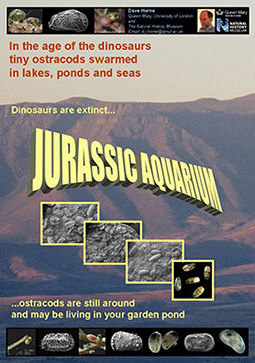
My outreach and public engagement activities at QMUL have included talks in schools and for local societies, contributions to school taster days at QMUL, a schools masterclass (on tsunami hazards) at the Royal Geographical Society, and Jurassic Aquarium, a video-microscopy demonstration of "living fossil" ostracods at a school half-term science day, held at the Turner Contemporary art gallery in Margate, Kent.
In 2014 I recorded a podcast on ostracods for the Palaeocast series:https://www.palaeocast.com/episode-35-ostracods/
In November 2016 I contributed a guest blog to the Loch Lleven National Nature Reserve web site: https://lochlevennnr.wordpress.com/2016/11/21/guest-blog-dave-horne/
In July 2018, while doing fieldwork in Orkney, I was interviewed by Huw Williams for Radio Orkney and BBC Radio Scotland broadcasts: https://www.bbc.co.uk/programmes/p06g5m5v
